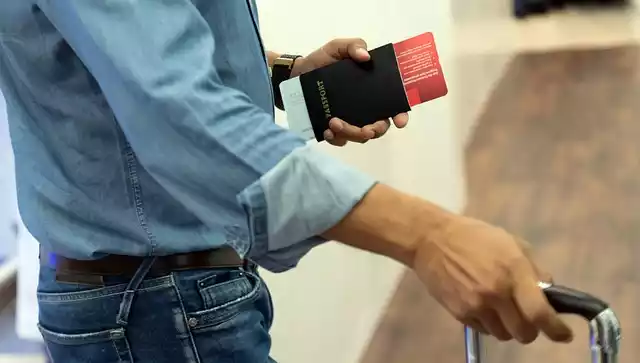In today’s interconnected world, international travel has become more accessible than ever. Whether you’re planning a business trip or a leisurely vacation, venturing beyond your borders opens up a world of new experiences and opportunities. However, managing your finances abroad can be a daunting task, especially when dealing with different currencies and exchange rates. This is where you must have the basic knowledge about what is travel card along with its benefits, features, etc. In this comprehensive guide, we will unravel the mysteries of travel cards and provide you with all the essential information you need to make informed decisions on your next globetrotting adventure.
Table of Contents
What is Travel Card?
A travel card, also known as a prepaid travel card or forex card or international travel card, is a specialized payment card that allows you to load multiple currencies onto a single card. Unlike traditional debit or credit cards, travel cards are specifically designed for international use, offering convenience and cost savings for globe-trotting travelers. They eliminate the need for carrying large sums of cash and provide a secure and efficient way to manage your finances while abroad.
Key Features and Benefits of Travel Cards
Whether you’re a seasoned traveler or an adventurous rookie, understanding the key features of travel cards will empower you to make informed decisions and maximize the value of your travel endeavors.
1. Unlocking Rewards and Earning Privileges
Travel cards often serve as gateways to a world of rewards and privileges that can elevate your travel experiences. Many cards offer generous sign-up bonuses, granting you a substantial influx of points or miles upon opening an account. These points can then be redeemed for a variety of travel-related expenses, including airfare, hotel stays, car rentals, and even cruises.
2. Embracing Foreign Transaction Fee-Free Transactions
The bane of many travelers’ existence, foreign transaction fees can quickly add up, diminishing the value of your travel expenses. Travel cards, however, often eliminate these pesky fees, allowing you to make purchases abroad without incurring additional costs. This feature is particularly beneficial for frequent travelers who regularly venture beyond their home country.
3. Indulging in Airport Lounge Access
The hustle and bustle of airports can be overwhelming, making a tranquil oasis a welcome respite. Many travel cards grant cardholders access to airport lounges, where you can unwind in comfort, enjoy complimentary refreshments, and utilize high-speed Wi-Fi while awaiting your flight.
4. Ensuring Travel Insurance and Protection
Travel cards often provide a comprehensive suite of travel insurance benefits, offering peace of mind during your adventures. These benefits may include trip cancellation/interruption insurance, lost luggage insurance, and emergency medical assistance.
5. Embracing Global Currency Management
Travel cards eliminate the hassle of currency exchange, allowing you to load multiple currencies onto a single card. This eliminates the need to carry large amounts of cash, reducing the risk of theft or loss. Moreover, travel cards often offer favorable exchange rates, saving you money on your transactions.
6. Enhancing Digital Security and Convenience
Travel cards provide enhanced security measures to safeguard your financial information, employing chip-and-PIN technology and robust fraud protection features. Additionally, many travel cards offer mobile apps that enable you to manage your account, track expenses, and receive real-time transaction notifications.
7. Exploring Special Travel Perks and Partnerships
Many travel cards offer exclusive perks and partnerships with airlines, hotels, and rental car companies. These benefits may include priority check-in, complimentary upgrades, and discounts on travel-related expenses.
8. Budgeting Made Easy
Travel cards empower you to set a budget for your trip by loading a specific amount onto the card. This not only helps you stick to your financial plan but also prevents overspending, ensuring a stress-free travel experience.
Types of Travel Cards

Normally there are four types of travel card, which are as follows:
1. Single Currency Travel Cards:
While most travel cards are multi-currency, some are designed for specific regions or countries. These single-currency cards are beneficial if you are traveling to a destination where a particular currency dominates.
2. Multi-Currency Travel Cards:
The most common type of travel card, multi-currency cards allow you to load and use various currencies on the same card. This versatility makes them ideal for globetrotters exploring multiple countries during a single trip.
3. Prepaid Debit Travel Cards:
Similar to regular debit cards, these travel cards are preloaded with funds, providing the convenience of a debit card while offering additional security features tailored for international use.
4. Airline or Reward Travel Cards:
Some travel cards are affiliated with specific airlines or reward programs, offering benefits such as air miles, discounts on flights, and other travel-related perks. These cards are ideal for frequent flyers loyal to a particular airline.
How to Choose the Right Travel Card?
Embarking on a journey, whether for business or pleasure, requires careful planning, and choosing the right travel card is a crucial aspect of that preparation. With a myriad of options available, finding the perfect travel card can be overwhelming. In this guide, we’ll walk you through the essential steps to help you make an informed decision and ensure that your travel card aligns seamlessly with your wanderlust.
- Understand Your Spending Habits: Before diving into the world of travel cards, take a moment to analyze your spending habits. Are you a frequent traveler or an occasional explorer? Understanding how you typically use your credit card will guide you towards a travel card that complements your lifestyle. Some cards offer specific rewards for travel-related expenses, while others focus on everyday purchases.
- Consider Your Travel Goals: Different travel cards cater to different goals. If you’re a frequent flyer, a card that offers airline miles or lounge access might be ideal. On the other hand, if your adventures involve diverse experiences, a general travel rewards card with flexible redemption options might be more suitable. Align your card choice with your travel aspirations to maximize the benefits.
- Evaluate Fees and Interest Rates: Pay close attention to the fees associated with the travel card. Look for cards with no foreign transaction fees to save on international expenses. Additionally, consider the annual fee and weigh it against the potential benefits offered by the card. Understanding the interest rates is also crucial, especially if you anticipate carrying a balance.
- Examine Rewards and Perks: Each travel card comes with its unique set of rewards and perks. Some cards offer cashback on travel expenses, while others provide points for hotel stays and rental cars. Look for a card that aligns with your preferences and offers rewards that you will actually use. Consider perks such as travel insurance, roadside assistance, and concierge services for added value.
- Check for Sign-Up Bonuses: Many travel cards come with enticing sign-up bonuses. These bonuses, often in the form of extra points or miles, can kickstart your travel rewards journey. However, be sure to understand the terms and conditions associated with these bonuses, such as minimum spending requirements and the expiration date of the rewards.
- Review Card Acceptance Worldwide: Ensure that the travel card you choose is widely accepted at your destination. Major credit card networks like Visa and Mastercard are generally recognized globally, providing you with the convenience of seamless transactions during your travels.
- Read User Reviews and Expert Opinions: Take advantage of online resources to gather insights from other travelers and experts. User reviews can provide valuable real-world experiences, while expert opinions can offer a broader perspective on the strengths and weaknesses of various travel cards. Consider both to make a well-informed decision.
Selecting the right travel card involves a careful consideration of your spending habits, travel goals, fees, rewards, and more. By following these steps and conducting thorough research, you can choose a travel card that not only complements your lifestyle but also adds value to your journeys. So, gear up, explore the options, and find the travel card that will be your trusted companion on the road to unforgettable adventures.
How to Get a Travel Card?

In the realm of travel, convenience and financial security are paramount to a seamless and enjoyable experience. Travel cards have emerged as a game-changer, offering a plethora of benefits that extend beyond mere currency exchange. Whether you’re an experienced traveler or a first-time adventurer, understanding how to acquire a travel card is essential for optimizing your travel endeavors. Embark on this journey of financial empowerment and discover the effortless process of obtaining a travel card.
Step 1: Identify Your Travel Needs and Preferences
Before embarking on your quest for a travel card, it’s crucial to assess your travel habits and preferences. Consider the frequency of your travels, the destinations you frequent, and the types of expenses you typically incur. This introspection will guide you in selecting a card that aligns with your travel style and maximizes its benefits.
Step 2: Research and Compare Travel Card Options
Once you have a clear understanding of your travel needs, delve into the world of travel cards. Conduct thorough research, comparing various card options from different issuers. Evaluate the features, fees, and benefits associated with each card, paying particular attention to factors such as:
- Currency loading options and exchange rates: Opt for cards that offer favorable exchange rates and allow you to load multiple currencies.
- Foreign transaction fee policies: Prioritize cards that eliminate or minimize foreign transaction fees.
- Rewards and benefits: Explore cards that offer generous sign-up bonuses, travel rewards, and comprehensive travel insurance.
- Airport lounge access: Consider cards that grant access to airport lounges, providing a haven of tranquility amidst the airport chaos.
- Security features: Ensure your chosen card employs robust security measures, including chip-and-PIN technology and fraud protection.
- Mobile app functionality: Choose a card with a user-friendly mobile app that facilitates account management, transaction tracking, and real-time notifications.
Step 3: Gather Required Documentation
Each travel card issuer may have specific documentation requirements, but generally, you’ll need to provide:
- Proof of identity: A valid passport or driver’s license
- Proof of residency: A recent utility bill or bank statement
- Social Security number or Individual Taxpayer Identification Number (ITIN)
- Income verification: In some cases, proof of income may be required.
Step 4: Apply Online or Visit a Branch
Most travel card issuers offer online application processes, allowing you to apply from the comfort of your home. Simply fill out the online application form, providing accurate and complete information. Alternatively, you can visit a branch of your chosen bank or financial institution to apply in person.
Step 5: Activate and Fund Your Travel Card
Upon approval, your travel card will be sent to your designated address. Once received, activate your card by following the instructions provided by the issuer. You can then fund your card by transferring funds from your bank account or making a direct deposit.
Additional Tips for Choosing a Travel Card:
- Consider cards that align with your existing reward programs or travel partners.
- Prioritize cards that offer global acceptance and ATM access.
- Read reviews and testimonials from other travelers to gain insights into card performance and customer service.
- Consult with a financial advisor for personalized recommendations based on your financial situation and travel goals.
Essential Tips for a Smooth Journey
To fully reap the benefits of your travel card and ensure a smooth financial experience, follow these practical tips:
- Load funds before your trip: Avoid exchange rate fluctuations and potential last-minute rushes by loading funds onto your travel card in advance.
- Inform your bank: Notify your bank about your travel plans to avoid card blocking or transaction restrictions. This ensures uninterrupted access to your funds during your trip.
- Monitor your transactions regularly: Keep track of your spending to avoid overdrawing your account and stay within your budget.
- Report lost or stolen cards immediately: Contact your card issuer promptly in case of any card issues. This allows for swift action to protect your funds and minimize the impact of any losses.
End Note on What is Travel Card
Travel cards have evolved from mere payment instruments to indispensable travel companions. By understanding the key features of travel cards, you can unlock a world of rewards, privileges, and protection, enhancing your travel experiences and maximizing the value of your adventures. So, whether you’re planning a cross-continental journey or a weekend getaway, consider equipping yourself with a travel card tailored to your travel style and preferences. Embrace the convenience, security, and benefits that travel cards offer, and embark on your next adventure with confidence and ease.
In the realm of international travel, a travel card emerges as a valuable asset, streamlining financial transactions and enhancing the overall journey. From multi-currency support to robust security features, these cards are tailored to meet the unique needs of globe-trotters. Armed with the knowledge gained from this guide, you’re now well-equipped to choose and use a travel card that best suits your travel aspirations. Bon voyage!
FAQs – related to What is Travel Card
What is travel card?
Travel cards, also known as prepaid travel cards or forex cards, are prepaid debit cards designed specifically for international travelers. They allow you to load multiple foreign currencies onto a single card, eliminating the need to carry large amounts of cash or multiple currency notes.
Is travel card and atm card same?
No, a travel card and an ATM card are not the same thing, although they both have some similarities.
ATM cards are debit cards that are primarily used to withdraw cash from ATMs. They can also be used to make in-store purchases. On the other hand, Travel cards are prepaid debit cards that are specifically designed for international travelers. They can be loaded with multiple foreign currencies, and you can use them to make payments, withdraw cash, and manage your expenses while traveling overseas.
What is the maximum limit of travel card?
As per Reserve Bank of India (RBI) regulations, presently an individual traveler is permitted to carry up to a maximum of USD $10,000 or its equivalent in foreign currencies during a calendar year.

